对外经贸大学:《国际企业管理 International business management》课程教学资源(案例)Case3:施乐和富士-施乐 ——通过战略联盟取胜
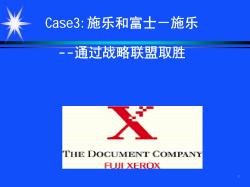
CaSe3:施乐和富士一施乐 --通过战略联盟取胜 THE DOCUMENT COMPANY 且川XEROX 1
1 Case3:施乐和富士-施乐 --通过战略联盟取胜

Synopsis (I) Many of the international alliances being formed today are still too young for us to evaluate their full impact. The case of Xerox and Fuji Xerox gives us a unique opportunity to trace the evolution of such an alliance over a long period of time.We can learn a lot from this experience,and try both to avoid Xerox's mistakes and copy Xerox's success. 2
2 Synopsis (I) Synopsis (I) Many of the international alliances being formed today are still too young for us to evaluate their full impact. The case of Xerox and Fuji Xerox gives us a unique opportunity to trace the evolution of such an alliance over a long period of time. We can learn a lot from this experience, and try both to avoid Xerox’s mistakes and copy Xerox’s success

While this case is about a particular type of alliance-a separate enterprise owned by Xerox and Fuji Photo Film- it also contains elements of other types of alliance. The relationship between Xerox and Fuji Xerox,for example,is itself managed through a series of technology and marketing contracts,organizational processes,and personal relationship-all basic elements in any collaborative venture. This case,therefore,should not suggest that an equity joint venture is an ideal form for an alliance.Rather,we should use it to examine the various elements that go into collaboration across borders. 3
3 While this case is about a particular ty p e of alliance—a separate enterprise owned b y Xerox and Fuji Photo Film — it also contains elements of other t ypes of alliance. The relatio nship bet ween Xerox and Fuji Xerox, for example, is itself managed through a series of technology and marketing contracts, organizational processes, and personal relationship—all basic elements in an y collaborative venture. This case, therefore, should not suggest that an equity joint venture is an ideal form for an alliance. Rather, w e should use it to examine the various ele ments that go into collaboration across borders
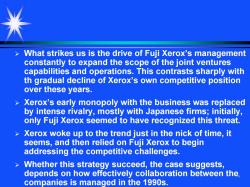
What strikes us is the drive of Fuji Xerox's management constantly to expand the scope of the joint ventures capabilities and operations.This contrasts sharply with th gradual decline of Xerox's own competitive position over these years. Xerox's early monopoly with the business was replaced by intense rivalry,mostly with Japanese firms;initially, only Fuji Xerox seemed to have recognized this threat. Xerox woke up to the trend just in the nick of time,it seems,and then relied on Fuji Xerox to begin addressing the competitive challenges. > Whether this strategy succeed,the case suggests, depends on how effectively collaboration between the. companies is managed in the 1990s
4 ¾ What strikes us is the drive of Fuji Xerox’s management constantly to expand the scope of the joint ventures capabilities and operations. This contrasts sharply with th gradual decline of Xerox’s own competitive position over these years. ¾ Xerox’s early monopoly with the business was replaced by intense rivalry, mostly with Japanese firms; initially, only Fuji Xerox seemed to have recognized this threat. ¾ Xerox woke up to the trend just in the nick of time, it seems, and then relied on Fuji Xerox to begin addressing the competitive challenges. ¾ Whether this strategy succeed, the case suggests, depends on how effectively collaboration between the companies is managed in the 1990s
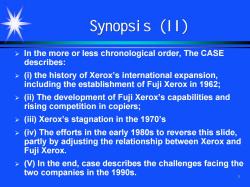
Synopsis (I1) In the more or less chronological order,The CASE describes: > (i)the history of Xerox's international expansion, including the establishment of Fuji Xerox in 1962; (ii)The development of Fuji Xerox's capabilities and rising competition in copiers; (iii)Xerox's stagnation in the 1970's (iv)The efforts in the early 1980s to reverse this slide, partly by adjusting the relationship between Xerox and Fuji Xerox. (V)In the end,case describes the challenges facing the two companies in the 1990s. 5
5 Synopsis (II) Synopsis (II) ¾ In the more or less chronological order, The CASE describes: ¾ (i) the history of Xerox’s international expansion, including the establishment of Fuji Xerox in 1962; ¾ (ii) The development of Fuji Xerox’s capabilities and rising competition in copiers; ¾ (iii) Xerox’s stagnation in the 1970’s ¾ (iv) The efforts in the earl y 1980s to reverse this slide, partl y by adjusting the relationship bet w e en Xerox and Fuji Xerox. ¾ (V) In the end, case describes the challenges facing the two companies in the 1990s
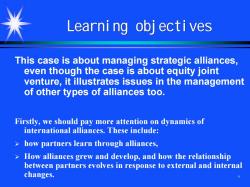
Learni ng obj ecti ves This case is about managing strategic alliances, even though the case is about equity joint venture,it illustrates issues in the management of other types of alliances too. Firstly,we should pay more attention on dynamics of international alliances.These include: how partners learn through alliances, How alliances grew and develop,and how the relationship between partners evolves in response to external and internal changes. 6
6 Learning objectives Learning objectives This case is about managing strategic alliances, even though the case is about equity joint venture, it illustrates issues in the management of other types of alliances too. Firstly, w e should pay more attention on dynamics of internation al a llianc es. These inc lude: ¾ how partners learn thr ough alliances, ¾ How alliances grew and develop, and how the rela tionship between partners evolv es in response to external and internal changes
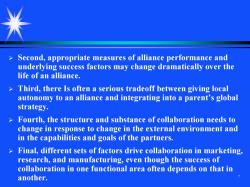
Second,appropriate measures of alliance performance and underlying success factors may change dramatically over the life of an alliance. Third,there Is often a serious tradeoff between giving local autonomy to an alliance and integrating into a parent's global strategy. Fourth,the structure and substance of collaboration needs to change in response to change in the external environment and in the capabilities and goals of the partners. Final,different sets of factors drive collaboration in marketing, research,and manufacturing,even though the success of collaboration in one functional area often depends on that in another
7 ¾ Second, appropriate measures of alliance performance and underlying success factors may change dramatically over the life of an alliance. ¾ Third, there Is often a serious tradeoff between giving local autonomy to an alliance and integrating into a parent’s global strategy. ¾ Fourth, the structure and substance of collaboration needs to change in response to change in the external environment and in the capabilities and goals of the partners. ¾ Final, different sets of factors drive collaboration in marketing, research, and manufacturing, even though the success of collaboration in one functional area often depends on that in another
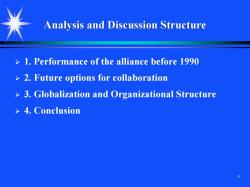
Analysis and Discussion Structure 1.Performance of the alliance before 1990 2.Future options for collaboration >3.Globalization and Organizational Structure >4.Conclusion 8
8 Analysis and ysis and Discussion Structure ussion Structure ¾ 1. Performance of the alliance before 1990 ¾ 2. Future options for collaboration ¾ 3. Globalization and Organizational Structure ¾ 4. Conclusion
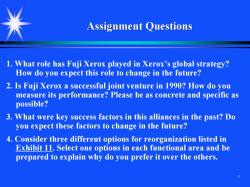
Assignment Questions 1.What role has Fuji Xerox played in Xerox's global strategy? How do you expect this role to change in the future? 2.Is Fuji Xerox a successful joint venture in 1990?How do you measure its performance?Please be as concrete and specific as possible? 3.What were key success factors in this alliances in the past?Do you expect these factors to change in the future? 4.Consider three different options for reorganization listed in Exhibit 11.Select one options in each functional area and be prepared to explain why do you prefer it over the others. 9
9 Assignment Ques nt Questions 1. What role has Fuji Xerox played in Xerox’s global strategy? How do you expect this role to change in the future? 2. Is Fuji Xerox a successful joint venture in 1990? How do you measure its performance? Please be as concrete and specific as possible? 3. What were key success factors in this alliances in the past? Do you expect these factors to change in the future? 4. Consider three different options for reorganization listed in Exhibit 11. Select one options in each functional area and be prepared to explain why do you prefer it over the others
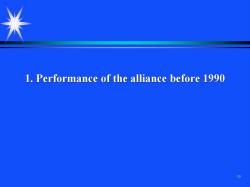
1.Performance of the alliance before 1990 10
10 1. Performance of the 1. Performance of the alliance bef ance before 1990 re 1990
按次数下载不扣除下载券;
注册用户24小时内重复下载只扣除一次;
顺序:VIP每日次数-->可用次数-->下载券;
- 对外经贸大学:《国际企业管理 International business management》课程教学资源(案例)CASE 2 Lincoln Electric; Venturing Abroad.pdf
- 对外经贸大学:《国际企业管理 International business management》课程教学资源(案例)CASE 1 INGVARKAMP RAD AND IKEA.pdf
- 对外经贸大学:《国际企业管理 International business management》课程教学资源(教学大纲).pdf
- 对外经贸大学:《管理信息系统》课程教学资源(PPT授课教案)17 系统设计.ppt
- 对外经贸大学:《管理信息系统》课程教学资源(PPT授课教案)16 系统调研与系统分析报告.ppt
- 对外经贸大学:《管理信息系统》课程教学资源(PPT授课教案)15 数据库设计.ppt
- 对外经贸大学:《管理信息系统》课程教学资源(PPT授课教案)14 企业的信息管理.ppt
- 对外经贸大学:《管理信息系统》课程教学资源(PPT授课教案)13 数据资源管理.ppt
- 对外经贸大学:《管理信息系统》课程教学资源(PPT授课教案)12 管理信息系统的开发方法.ppt
- 对外经贸大学:《管理信息系统》课程教学资源(PPT授课教案)11 信息系统开发.ppt
- 对外经贸大学:《管理信息系统》课程教学资源(PPT授课教案)10 计算机网络与信息系统.ppt
- 对外经贸大学:《管理信息系统》课程教学资源(PPT授课教案)09 系统.ppt
- 对外经贸大学:《管理信息系统》课程教学资源(PPT授课教案)08 系统设计.ppt
- 对外经贸大学:《管理信息系统》课程教学资源(PPT授课教案)07 信息系统开发(系统分析).ppt
- 对外经贸大学:《管理信息系统》课程教学资源(PPT授课教案)06 信息系统开发篇(系统规划).ppt
- 对外经贸大学:《管理信息系统》课程教学资源(PPT授课教案)05 管理信息系统 Management Information System(MIS).ppt
- 对外经贸大学:《管理信息系统》课程教学资源(PPT授课教案)04 ERP的开发与应用(周庆).ppt
- 对外经贸大学:《管理信息系统》课程教学资源(PPT授课教案)03 信息与信息系统.ppt
- 对外经贸大学:《管理信息系统》课程教学资源(PPT授课教案)02 管理系统.ppt
- 对外经贸大学:《管理信息系统》课程教学资源(PPT授课教案)01 A公司管理信息系统.ppt
- 对外经贸大学:《国际企业管理 International business management》课程教学资源(案例)Case4 Canon:Competing on the capabilities.pdf
- 对外经贸大学:《国际企业管理 International business management》课程教学资源(案例)Case5 Caterpillar Tractor.pdf
- 对外经贸大学:《国际企业管理 International business management》课程教学资源(案例)Case6 Jollibee Foods Corporation 快乐蜂(Jollibee)快餐连锁店的国际扩张历程.pdf
- 对外经贸大学:《国际企业管理 International business management》课程教学资源(授课教案)第一篇 导论 第一章 跨国公司与跨国经营.pdf
- 对外经贸大学:《国际企业管理 International business management》课程教学资源(授课教案)第二篇 跨国经营理论 Part Two International Business Theories and Practices(第二章 基于贸易的跨国经营理论、第三章 基于外国直接投资(FDI)的跨国经营理论).pdf
- 对外经贸大学:《国际企业管理 International business management》课程教学资源(授课教案)第二篇 跨国经营理论 第三章 基于外国直接投资(FDI)的跨国经营理论.pdf
- 对外经贸大学:《国际企业管理 International business management》课程教学资源(授课教案)第四章 基于发展中国家和地区的跨国经营理论.pdf
- 对外经贸大学:《国际企业管理 International business management》课程教学资源(授课教案)第三篇 跨国进入战略 第五章 跨国进入分析.pdf
- 对外经贸大学:《国际企业管理 International business management》课程教学资源(授课教案)第三篇 跨国进入战略 第六章 跨国进入方式.pdf
- 对外经贸大学:《国际企业管理 International business management》课程教学资源(授课教案)第四篇 跨国经营战略篇 第七章 获得全球竞争优势.pdf
- 对外经贸大学:《国际企业管理 International business management》课程教学资源(授课教案)第四篇 跨国经营战略篇 第八章 跨国企业营销战略.pdf
- 对外经贸大学:《国际企业管理 International business management》课程教学资源(授课教案)第四篇 跨国经营战略篇 第九章 跨国企业的资源寻求战略.pdf
- 对外经贸大学:《国际企业管理 International business management》课程教学资源(授课教案)第五篇 走出去战略 第十章 中国企业跨国经营战略.pdf
- 对外经济贸易大学:《营销学原理》课程教学大纲 Principles of Marketing(英文).pdf
- 对外经济贸易大学:《营销学原理》课程教学资源(试题)2001-2002期末考试试卷一(英文,含答案).pdf
- 对外经济贸易大学:《营销学原理》课程教学资源(试题)1997-1998期末考试试卷二(英文,含答案).pdf
- 对外经济贸易大学:《营销学原理》课程教学资源(教学方案,英文).pdf
- 对外经贸大学:《人力资源管理 Human Resource Management》课程教学资源(作业)Chapter 1 Human Resource Management:Gaining a Competitive Advantage.pdf
- 对外经贸大学:《人力资源管理 Human Resource Management》课程教学资源(作业)Chapter 2 Strategic Human Resource Management.pdf
- 对外经贸大学:《人力资源管理 Human Resource Management》课程教学资源(作业)Chapter 3 The Analysis and Design of Work.pdf
